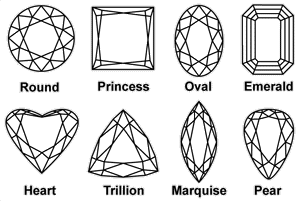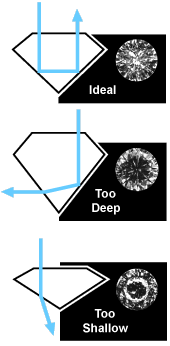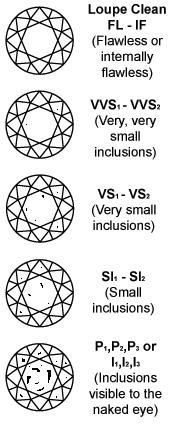Ross Ezekiel Jewellery

Anatomy of a Diamond
Table: The largest facet of a diamond.
Girdle: The narrow band of a diamond held by the setting.
Culet: The small flat face at the bottom of a diamond. The preferred culet is not visible with the naked eye.
Crown: The top portion of a diamond below the table and above the girdle.
Pavilion: The bottom portion of a diamond below the girdle and above the culet.
Diameter: The width of a diamond as measured through the girdle.
Depth: The height of a diamond as measured from the culet to the table.

Buying a Diamond
Before buying a diamond it is important to learn some of the terminology used by jewellers to describe a diamond. Most importantly you should educate yourself about the four C's - Cut, Carat, Clarity and Colour. Jewellers use these four fundamental criteria to judge the quality and value of a diamond. By knowing what to look for you can make sure you are getting value for money.
After reading through this guide, you will be ready to choose the diamond that is right for you. If you would like more information on how to buy a diamond please contact Ross Ezekiel.


Cut
When jewellers judge the quality of a cut diamond, they often rate "Cut" as the most important of the four C's. The key is not the shape, but how well the cutter has executed that shape. The diamond's proportions, specifically the width and depth, determine how well light will reflect and refract within the diamond. A well executed round cut should reflect most of the light out of the table and make the diamond appear white when viewed from the top. An inferior cut will produce a stone that appears dark at the center and in some extreme cases the ring settings may show through the top of the diamond as shadows. Even if a diamond has perfect colour and clarity, a diamond with a poor cut will have dulled brilliance.
Sometimes diamond cutters will compromise and accept lesser proportions and symmetry in order to avoid "inclusions" (flaws) or to preserve the carat rating. Since the per-carat price of diamond is much higher when the stone is over one carat, many one-carat diamonds are the result of compromising "Cut" for "Carat".
The "Cut" of a diamond is the most difficult criterion for the buyer to assess when selecting a good diamond, because a diamond certificate will only have a list of proportions and a rating such as "Very Good", "Good" or "Unusual". It requires a trained eye to see the quality of a good cut, so it is important to get advice from a jeweller you can trust.

Carat
As with all precious stones, the weight of a diamond is expressed in carats. In the past, carob seeds were used as the weights of precision scales because of their uniform size, today the metric carat is standardized at 0.2 grams. One carat is further subdivided into 100 points, so that a quarter carat diamond = 25 points = 0.05 grams. Since the larger diamonds are rarer than smaller diamonds, diamond value tends to increase exponentially with carat weight. But bigger is not necessarily better, lower quality cuts are sometimes used to maximize the weight of a diamond. Careful consideration should be given to all of the four C's to make sure you are getting value for money.

Clarity
Clarity is a measure of structural imperfections within a diamond - called "inclusions". Almost all diamonds contain minute traces of non-crystallized carbon or small non-diamond crystals. However, the fewer there are, the more valuable the stone will be.
Most inclusions are not discernible to the naked eye, hence diamonds are graded by an experience grader when viewed at 10 times magnification.
The following is a list of grades used by diamond graders to compare the clarity;
Loupe Clean or FL: "flawless" in that no inclusions are visible under 10 times magnification.
IF: "internally flawless" with no inclusions visible under 10 times magnification, only small blemishes.
VVS1 and VVS2: "very very small" inclusions that are difficult to see under 10 times magnification. VVS1 is a better grade than VVS2.
VS1 and VS2: "very small" inclusions and visible under magnification but invisible to the naked eye.
SI1 and SI2: "small inclusions" that can be noticeable to the naked eye, if you know where to look.
P1, P2 and P3 or I1, I2 and I3: "imperfect" and visible to the naked eye. For P3 (or I3), the inclusions are large and obvious and impact the brilliance of the diamond.
Beyond the grading terms, other considerations include the type, size and location of the inclusion. Inclusions near or on the surface may weaken the diamond structurally. Depending on where the inclusion occurs in the cut diamond and how it is to be used, it may be possible to hide the inclusion behind the setting.
Please Note: Clarity can be enhanced by treatments such as fracture filling and laser drilling, these significantly reduce the value of a diamond and reputable vendors should disclose any treatments to the buyer.

Colour
The colour of a diamond is determined by comparing it to an internationally approved set of master stones. The diamond is given a letter from "D" to "Z" where "D" is colourless and "Z" is yellow. Colourless diamonds are priced higher than yellow diamonds. When a diamond's colour is more intense than the "Z" grading, it is known as a "Fancy Colour". The value of a Fancy Colour diamond may far surpass that of colourless diamond, if the intensity of the colour is high and the colour is rare.
The Fifth C
The quality of a diamond is judged on many different attributes, some can be easily seen, others require a trained eye. A diamond should come with a certificate from a reputable laboratory, which will contain a complete evaluation of the diamond performed by a qualified professional.Certificates are useful for diamond buyers because they provide an objective quality assessment by an independent grading laboratory which has no financial interest in the diamond. For more information about diamond certificates please see the Diamond Certification Laboratory of Australia website.